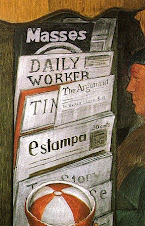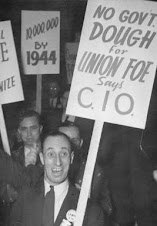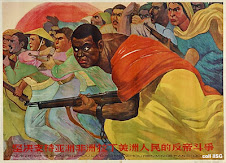
by Fred Goldstein
The massive demonstrations and occupation of the Capitol in Madison, Wis., signal the end of three decades of union retreat. This struggle has awakened a new activism, resistance and solidarity by labor, communities and students not seen in this country in many decades.
The bankers and bosses continue to move relentlessly in a right-wing, anti-labor, anti-people direction. Corporate puppets in state houses across the country are intent on budget cuts and attacks on public employees, education and social services.
But the rank and file down below are moving in the opposite direction — the direction of resistance. Wisconsin was only the first step. The growing conflict between these two opposing class forces is headed toward a revival of the class struggle on a broad basis.
The intransigence of the budget-cutters is pushing all sectors of the masses in the direction of forging a united struggle. The entire working-class population — employed and unemployed, organized and unorganized, youth and seniors, gay and straight, disabled, immigrants, documented and undocumented — is sharply targeted by this new stage of capitalist austerity.
The Washington Post summed things up on March 25: “Across the country, governors and legislators are moving to squeeze the pay and benefits of state and local government workers, privatize a wide range of public services and facilities, and sharply reduce state funding for programs that were once all but untouchable, including public schools, universities and unemployment benefits. They’re aiming to close budget gaps projected to be a cumulative $125 billion next year.”
They plan to take $125 billion away from the people and hand it over to the banks and bondholders who are demanding repayment of the state and municipal debt. These parasitic millionaires and billionaires, who live off the public treasury, got bailed out to the tune of trillions of dollars during the financial meltdown. And they continue to take — even as the unemployment crisis, the low-wage crisis, the foreclosure crisis, the hunger crisis and the health care crisis bring increasing suffering and hardship to tens of millions.
Protests, solidarity continue
Gov. Scott Walker in Wisconsin is their advance man. But Walker and his cohorts did not reckon on the Madison teachers walking out for three days, followed by their students. They did not reckon on the occupation of the Capitol for two weeks. And the bankers did not expect that tens of thousands of workers would come from all over the country to support the Wisconsin struggle.
Nor did they expect tens of thousands of unionists and their supporters to demonstrate in solidarity in cities all over the country, large and small, and to fight back against their own budget-cutters.
Demonstrations of solidarity and resistance have taken place at state houses and government buildings in Ohio, Indiana, Michigan, Missouri, Pennsylvania, Tennessee, New York, Illinois, Iowa, Rhode Island and Florida — all within the last month. And they are not slowing down.
Some 15,000 people demonstrated in Los Angeles on Solidarity Saturday, March 26. Mahlon Mitchell, the head of the Wisconsin State Firefighters Association and the first Black president of that union — who has played a prominent role in the struggle — was a main speaker at the rally, along with many other union officials.
In New York on March 24, several thousand demonstrators rallied at City Hall and marched to Wall Street to protest Democratic Gov. Andrew Cuomo’s $132 billion budget cuts and to express solidarity with Wisconsin. While just a beginning, it was important because, like Los Angeles, New York is a bastion of the multinational working class in a highly unionized state. The demonstration was an alliance among unions, students and community organizations.
Labor, student and community activists in Wisconsin are continuing the struggle after the illegal passage of Walker’s union-busting bill. Teachers in Michigan have been told by their union to begin saving up in case of a strike — which would be illegal according to Michigan anti-labor law.
Unions become ‘organizing centers of the working class’
No one can foretell how this new phase of the struggle will evolve. What is certain is that Wisconsin has launched a new phase of union activism and solidarity. Moreover, community organizations and activists who have been fighting for years have consciously identified their causes with the rights of public workers and unions. The same can be said for student organizations and activists. They all understand the potential power of the organized working class and are moving toward one another in practice.
This is a move in the direction of a broader concept of the class struggle. It will hopefully be fully embraced by the unions, by rank-and-file leaders especially, who seek to build the strongest front in the struggle.
The direction for the movement to take was advocated by none other than Karl Marx in 1866, in his famous address to the First International on “The Future of the Unions”:
“Apart from their original purpose, they [the unions] must now learn to act deliberately as organizing centers of the working class in the broad interest of its complete emancipation. They must aid every social and political movement tending in that direction. Considering themselves as acting as the champions of the whole working class, they cannot fail to enlist the non-society men [unorganized workers — ed.] into their ranks. They must look carefully after the interests of the worst paid trades, such as agricultural laborers, rendered powerless by exceptional circumstances. They must convince the world at large that their efforts, far from being narrow and selfish, aim at the emancipation of the downtrodden millions.” (Cited in Goldstein, “Low-Wage Capitalism,” World View Forum, 2008)
Marx pointed in the direction of a broad, all-encompassing vision of the union movement, a social movement uniting the struggles of all the exploited and oppressed. This is the direction that all revolutionary Marxists and activists must promote.
This new stage is not a temporary development. It is driven by profound forces. This author wrote in “Low-Wage Capitalism”: “Globalization, capitalist restructuring, the hardships of low-wage capitalism, and growing racism and national oppression are creating the material basis for a new era of rebellion and class unity. As the working class has become poorer, the proportion of African-American, Latino/a, Asian, women, lesbian, gay, bi and trans workers has become greater. At the same time white workers have also become poorer.”
These reactionary forces are “destroying the basis for class collaboration and class compromise with the bosses. These changes are creating the foundation for building a broad working-class movement which fights for the multinational working class as a whole. ...
“The rank and file of the workers’ movement will be compelled by new conditions to assert itself and exercise leadership in the struggle. Such a movement, because it is rooted in the communities of the working class and the oppressed, will be able to go beyond narrow trade unionism, which limits itself to bargaining for wages and conditions, and fight for economic, social, and political justice on all fronts in the struggle against capitalism, and ultimately against the condition of wage slavery itself.”
Email: fgoldstein@workers.org










































No comments:
Post a Comment